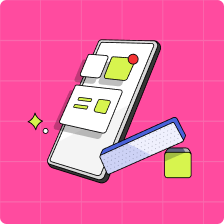There are so many temptations as a teen. From buying the latest kicks to getting concert tickets to see their favourite band. It’s not easy for them to figure out how to divvy up their money. As a parent, you want to provide the best financial education for your teens so they make smart money decisions.
Budgeting is one of the best ways for teens to learn to manage their money responsibly. In particular, zero-based budgeting can be an effective tool to help teens give each dollar a purpose. Use this guide to help teens learn what a zero-based budget is, the pros and cons of using this method, and how your teen can create one.
What is zero-based budgeting (ZBB)?
A zero-based budget or ZBB (as the cool kids would say), is a method where you allocate every dollar of your income and assign it to either an expense or savings goal. Simply put, you take all your income sources and subtract your expenses and savings, to equal zero.
It’s a popular tool used in the corporate world but has since been adapted to suit our everyday financial needs. It can be a fun exercise for parents to show their teens how to create a zero-based budget to see where their money flows in and out. What’s more, with a looming recession, it’s a good opportunity to talk to your teens about how to prepare for it using a budget.

Why use a zero-based budget?
There are a number of reasons teens would use a zero-balanced budget. First, it may help them learn how to stay out of debt, which can be helpful when they are old enough to have a credit card or a student loan. They will also benefit from having a spending plan for the upcoming month and avoiding impulse purchases.
Read more: How to apply for your first credit card
Plus, it provides the flexibility to modify the budget on a monthly basis based on your goals or needs. For example, in one month your kids may allocate more money towards back-to-school shopping, or another month they’ll want to buy a new outfit to attend a semi-formal.
Lastly, it can be better suited for families whose monthly expenses don’t neatly fit into a 50/30/20 budget—which is where you would allocate 50 per cent towards your needs, 30 per cent for wants and 20 per cent for savings. With the rising cost of living, this formula may no longer serve some Canadian households, which is why the zero-based budget may be a better fit.
Zero-based budgeting vs traditional-based budgeting
There are similarities between the two types of budgets. However, here are some key differences:
| Zero-based budgeting | Traditional-based budgeting |
| Encourages you to justify both old and new expenses | Focuses on analyzing new expenses |
| Balancing the calculation to zero | Uses the previous budget as a base |
| More time consuming and complex | Easier to implement |
| Based on a forecast | Based on historical information |
What are the pros and cons of a zero-based budget?
Based on your financial situation, you may consider weighing the advantages and disadvantages of having a zero-based budget:
Pros
- It can help you curb impulsive spending since social media makes it easier to spend money online.
- It helps ensure you don’t live beyond your means.
- You can customize it to your wants and needs.
- A zero-based budget allows you to make adjustments along the way.
- It shows where you’re overspending and gives you the ability to decide where to cut down costs.
- It helps motivate teens to work towards their savings goals.
Cons
- It can be time-consuming to maintain a zero-based budget, especially when you’re juggling numerous extracurricular activities and homework.
- It can be challenging for teens with unpredictable incomes. For instance, your kids are probably working part-time while in school and may not have stable paycheques.
- You may need to reallocate your funds based on your spending habits.
- It could be challenging to stick to a zero-based budget if you have unexpected expenses.
How to create a zero-based budget
Ready to give zero-based budgeting a try? Here are the steps you need to take to create a zero-based budget. You can either record this in a notebook or a spreadsheet.

1. Determine your monthly income
The first step is to make a list of all your sources of income along with the amounts. This may include:
- A part-time job (e.g. babysitting, working at a store)
- Tips you receive from customers
- Weekly allowance
- Tasks you’ve completed through Mydoh
- Earning money online (e.g. Youtube channel or gaming)
- Monetary gifts
It may take awhile when you do this exercise for the first time. Keep in mind, it will get easier each month as you’ll have a track record of everything. Don’t worry if your teens’ income fluctuates from month to month—that’s completely normal.
2. Outline monthly expenses
The second step is to determine your expenses and how much you want to spend in each category. Here are some examples of expenses you may have:
- Transportation (e.g. car, public transport)
- Food (e.g. dining out, take-out, groceries)
- Clothing
- Entertainment (e.g. movies, concerts)
- Gifts
- Sports (e.g. gym membership)
- Phone bill
- Personal care (e.g. hair cut, cosmetics)
In this section, you’ll also want your teens to figure out some of their future savings goals. Some common goals may include saving for:
- Post-secondary school tuition
- A summer vacation
- Buying a new laptop
Although debt is less common for teens, if you’ve co-signed for your teens’ cell phone plan, then they may have shared responsibility to pay for it. Also, if they’re using the family car to go on trips, they could be chipping in to cover the car loan or insurance. If this applies to them, they’ll want to ensure they have money set aside to pay for these types of debts.
3. Make the budget equal zero
Now it’s time to take your total income and subtract all of your expenses which should equal $0. If your kids discover that they don’t have enough money, then you’ll have to come up with creative ways to either increase their income or cut down on costs (or both!). If they have leftover money, it can be allocated towards an emergency savings fund or to allow them more freedom to spend on other expenses.
4. Track your expenses
The next step is an important one: keeping tabs on their spending. For example, when your teen goes out to see a movie with their friends, grabs lunch or purchases a new pair of jeans, they’ll deduct the amount they spent from the respective categories.
Throughout the month, they’ll be able to see whether they are on track with what they have budgeted. Checking in with them to have a discussion about what adjustments they would like to make may be a good way to get them to understand how their spending habits align with their budget. Ultimately it will depend on what the financial priorities are for your teen.

How a zero-based budget can help teens
By completing this type of budget your teens can start to reap the benefits. For starters, it’ll help them differentiate between their wants and needs (and ask themselves “do I really need these shoes right now?”). They’ll also realize that money is a finite resource and they will have to weigh out the pros and cons of each purchase.
And with inflation, it’s worth pointing out to them that the cost of buying their favourite frappuccino will rise over time. This means they’re learning that a dollar today does not have the same purchasing power as a dollar tomorrow. That’s why starting off with a zero-based budget in their teenage years will help them build a solid foundation of money management skills that they can apply as they start their careers as young adults.
As your teens complete this activity every month, they’ll notice how each month’s expenses can vary. For instance, during the holiday season they’ll want to spend more money on gifts while in the summer, they might want to spend money on dining out with their friends.
Bonus points: if you can encourage your kids to do this for the next 12 months, they’ll get a big-picture overview of their annual cost of living.
The best part of learning zero-based budgeting is that it gives them control over how they want to allocate their money.
The bottom line
Now that you understand how a zero-based budget works, it’s a powerful tool that will help your kids become confident in how they manage their money. Hopefully, this will help to create a conversation about their personal finances in your household so that you are one step closer to raising money-smart kids.
Don’t forget that Mydoh gives tweens and teens the opportunity to build sound habits that will prepare them for when they start earning some real dough. When they look back on their youth, they’ll appreciate that you’ve taken the time to teach them the budgeting skills that will last them a lifetime.
Download Mydoh and get started today.
This article offers general information only and is not intended as legal, financial or other professional advice. A professional advisor should be consulted regarding your specific situation. While the information presented is believed to be factual and current, its accuracy is not guaranteed and it should not be regarded as a complete analysis of the subjects discussed. All expressions of opinion reflect the judgment of the author(s) as of the date of publication and are subject to change. No endorsement of any third parties or their advice, opinions, information, products or services is expressly given or implied by Royal Bank of Canada or its affiliates.








